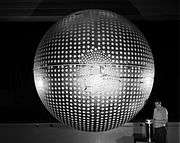Explorer 24
 Explorer 24. | |
| Mission type | Earth science |
|---|---|
| Operator | NASA |
| COSPAR ID | 1964-076A[1] |
| SATCAT no. | 931 |
| Mission duration | 1,426 days[2] |
| Spacecraft properties | |
| Bus | ADE bus |
| Manufacturer | Langley Research Center |
| Launch mass | 8.6 kg (19 lb) |
| Start of mission | |
| Launch date | 21 November 1964, 17:09:39 UTC[3][4] |
| Rocket | Scout X-4[5] |
| Launch site | Vandenberg SLC-5[5] |
| End of mission | |
| Decay date | 18 October 1968[1] |
| Orbital parameters | |
| Reference system | Geocentric |
| Regime | Low Earth |
| Eccentricity | 0.12496[1] |
| Perigee | 525 km (326 mi)[1] |
| Apogee | 2,498 km (1,552 mi)[1] |
| Inclination | 81.4°[1] |
| Period | 116.3 minutes[1] |
| Epoch | 21 November 1964[1] |
| Instruments | |
|
Nonsystematic Changes of Air Density Systematic Changes of Air Density | |
Explorer 24 (also called AD-B and S-56C) wan an U.S. satellite to atmospheric studies. Explorer 24 was launched on 21 November 1964 from Vandenberg Air Force Base, Lompoc, California, with Scout rocket. Explorer 24 was released along with its successor satellite, Explorer 25.
Mission
Explorer 24 was placed in orbit together with Explorer 25 from a single launch vehicle. Explorer 24 was identical in configuration to the previously launched balloon satellites Explorer 9 and 19. The spacecraft was 3.6 m in diameter, was built of alternating layers of aluminum foil and plastic film, and was covered uniformly with 5.1-cm white dots for thermal control.
It was designed to yield atmospheric density near perigee as a function of space and time from sequential observations of the sphere's position in orbit. To facilitate ground tracking, the satellite carried a 136 MHz tracking beacon.
The satellite reentered the earth's atmosphere on October 18, 1968.[1]
Results
Explorer 24 helped determine the variation in density between the day and night of the Earth and gave rise to studies on the zone winds in the exosphere, at an altitude of between 450 kilometres (280 mi) and 620 kilometres (390 mi).[6][7]
References
- 1 2 3 4 5 6 7 8 9 "S 55C". NSSDC Master Catalog. NASA Goddard Space Flight Center. Retrieved 10 June 2018.

- ↑ "1964-076A - Explorer 24". Space 40 (in Czech). Lubor Lejček, Antonín Vítek. Retrieved 10 June 2018.
- ↑ "Launch Log". Jonathan's Space Page. Retrieved June 10, 2018.
- ↑ "Letter dated 5 February 1965 from the Permanent Representative of the United States of America addressed to the Secretary-General". COMMITTEE ON THE PEACEFUL USES OF OUTER SPACE. UNOOSA. November 30, 1964. Retrieved 10 June 2018.
- 1 2 "Explorer". Encyclopedia Astronautica. Mark Wade. Retrieved 10 June 2018.
- ↑ "The Shape and Location of the Diurnal Bulge in the Upper Atmosphere". SAO Special Report (207). Jacchia, L. G. & Slowey, J. 1966. Retrieved 10 June 2018.
- ↑ "Exospheric zonal winds between 540 and 620 km from the orbit of Explorer 24". Planetary and Space Science 24: 529–539. Blum, P. W.; Schuchardt, K. G. H. June 24, 1976. Retrieved June 10, 2018.
.png)